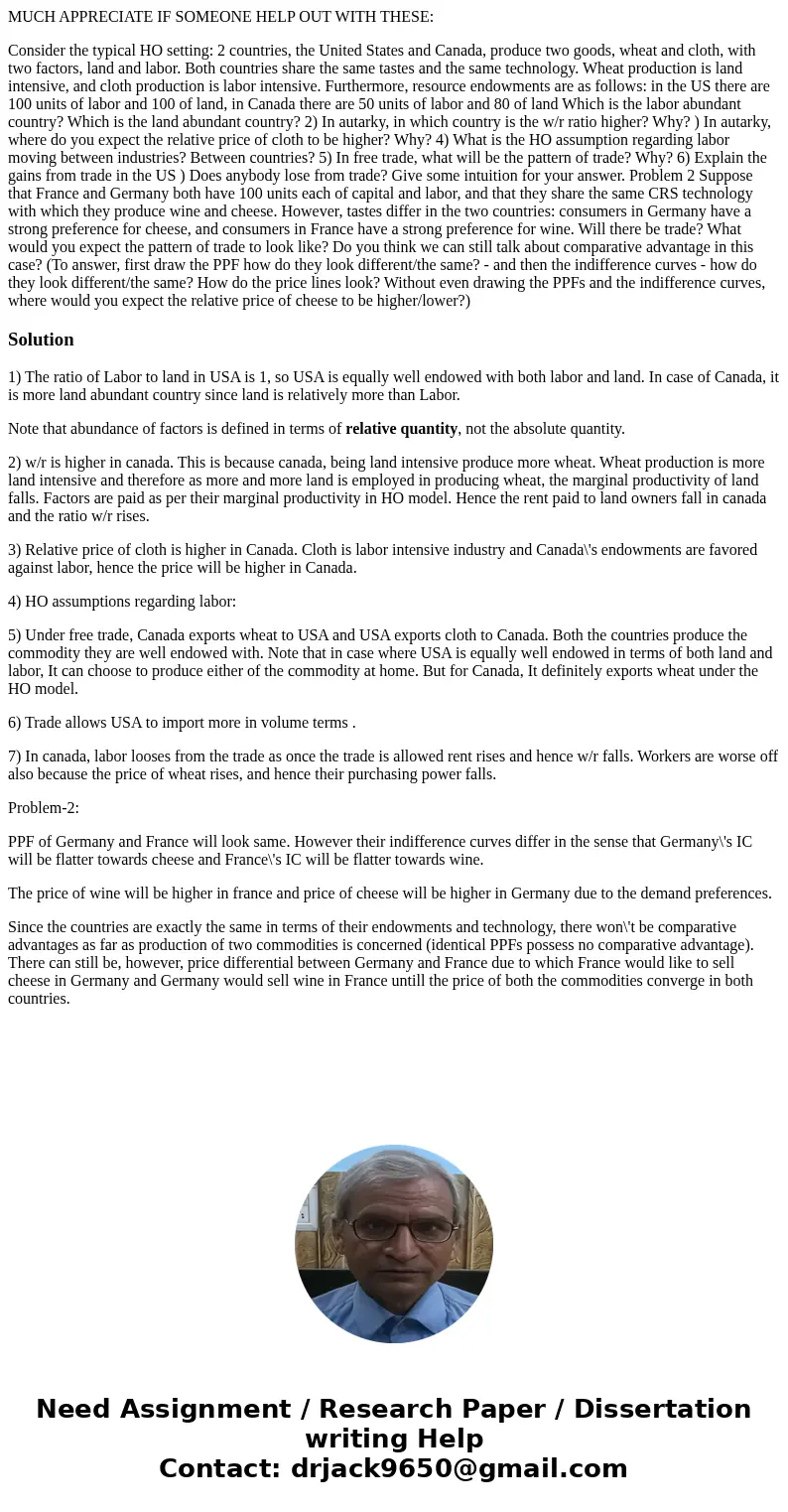MUCH APPRECIATE IF SOMEONE HELP OUT WITH THESE Consider the
MUCH APPRECIATE IF SOMEONE HELP OUT WITH THESE:
Consider the typical HO setting: 2 countries, the United States and Canada, produce two goods, wheat and cloth, with two factors, land and labor. Both countries share the same tastes and the same technology. Wheat production is land intensive, and cloth production is labor intensive. Furthermore, resource endowments are as follows: in the US there are 100 units of labor and 100 of land, in Canada there are 50 units of labor and 80 of land Which is the labor abundant country? Which is the land abundant country? 2) In autarky, in which country is the w/r ratio higher? Why? ) In autarky, where do you expect the relative price of cloth to be higher? Why? 4) What is the HO assumption regarding labor moving between industries? Between countries? 5) In free trade, what will be the pattern of trade? Why? 6) Explain the gains from trade in the US ) Does anybody lose from trade? Give some intuition for your answer. Problem 2 Suppose that France and Germany both have 100 units each of capital and labor, and that they share the same CRS technology with which they produce wine and cheese. However, tastes differ in the two countries: consumers in Germany have a strong preference for cheese, and consumers in France have a strong preference for wine. Will there be trade? What would you expect the pattern of trade to look like? Do you think we can still talk about comparative advantage in this case? (To answer, first draw the PPF how do they look different/the same? - and then the indifference curves - how do they look different/the same? How do the price lines look? Without even drawing the PPFs and the indifference curves, where would you expect the relative price of cheese to be higher/lower?)Solution
1) The ratio of Labor to land in USA is 1, so USA is equally well endowed with both labor and land. In case of Canada, it is more land abundant country since land is relatively more than Labor.
Note that abundance of factors is defined in terms of relative quantity, not the absolute quantity.
2) w/r is higher in canada. This is because canada, being land intensive produce more wheat. Wheat production is more land intensive and therefore as more and more land is employed in producing wheat, the marginal productivity of land falls. Factors are paid as per their marginal productivity in HO model. Hence the rent paid to land owners fall in canada and the ratio w/r rises.
3) Relative price of cloth is higher in Canada. Cloth is labor intensive industry and Canada\'s endowments are favored against labor, hence the price will be higher in Canada.
4) HO assumptions regarding labor:
5) Under free trade, Canada exports wheat to USA and USA exports cloth to Canada. Both the countries produce the commodity they are well endowed with. Note that in case where USA is equally well endowed in terms of both land and labor, It can choose to produce either of the commodity at home. But for Canada, It definitely exports wheat under the HO model.
6) Trade allows USA to import more in volume terms .
7) In canada, labor looses from the trade as once the trade is allowed rent rises and hence w/r falls. Workers are worse off also because the price of wheat rises, and hence their purchasing power falls.
Problem-2:
PPF of Germany and France will look same. However their indifference curves differ in the sense that Germany\'s IC will be flatter towards cheese and France\'s IC will be flatter towards wine.
The price of wine will be higher in france and price of cheese will be higher in Germany due to the demand preferences.
Since the countries are exactly the same in terms of their endowments and technology, there won\'t be comparative advantages as far as production of two commodities is concerned (identical PPFs possess no comparative advantage). There can still be, however, price differential between Germany and France due to which France would like to sell cheese in Germany and Germany would sell wine in France untill the price of both the commodities converge in both countries.

 Homework Sourse
Homework Sourse